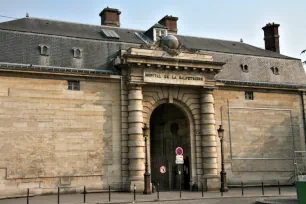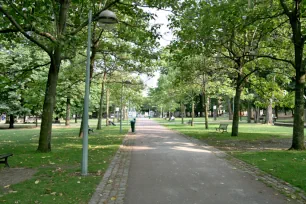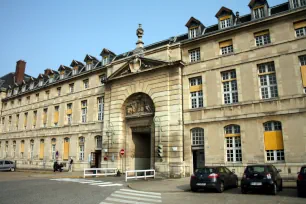The Hôpital de la Salpêtrière is the most monumental hospital complex in Paris. It was originally built in the seventeenth century and gained recognition in the eighteenth and nineteenth centuries for its advances in the treatment of neurological disorders.
The Hospital




In 1565 King Louis XIV decided to create a new institution that would serve to intern some of the 50,000 beggars, homeless, thieves and other outcasts who roamed the streets of Paris.
The institute, initially called the Hôpital Général, was built on the site of a former gunpowder factory, situated just south of the Parisian suburb of St-Victor. The factory was known as Salpêtrière (saltpeter works), since the key ingredient was powder, and the new institution was soon given the same name.
Construction of the Salpêtrière hospital started in 1660 and was completed in 1680. In 1684 a prison for women and a remand home for minors were added to the complex. Orphans and, from 1795 on, the mentally impaired were also interned in the Salpêtrière.
In the late eighteenth century, during the Age of Enlightenment, the hospital became known for its humane treatment of mental patients. In 1795 the physician Pinet was the first to abolish the shackling of the mentally ill. The Salpêtrière gained a reputation for psychiatry, and in the nineteenth century it was the largest neurological institute in Europe. The groundbreaking work of Jean-Martin Charcot on the subject of mental disorders gained recognition across the continent. Sigmund Freud is known to have attended his theatrical lectures, during which Charcot often hypnotized patients suffering from hysteria.
The Buildings
The Wings
The Salpêtrière complex was designed by Louis Le Vau, but since he was too preoccupied with other projects such as the expansion of the Vincennes Castle, he left the actual construction to his assistants Duval and Le Muet.
Construction of the north-east wing, the Division Masarin, started in 1660. The south wing, the Division Lasay, was built much later, in 1756, by Antoine-Jacques Payen and Germain Boffrand, following the original plans. The design of the two long wings is similar to that of the 1676 Hôtel des Invalides, with a rather austere facade, accentuated only by monumental gateways that are decorated with pediments and reliefs.
The Chapel

The two wings flank the monumental Chapelle Saint-Louis, also designed by Le Vau. The chapel was built between 1670 and 1680 under the guidance of Libéral Bruant, the architect of Les Invalides, which was built at the same time.
The chapel has a traditional floor plan in the shape of a Greek cross, with four equal wings and an octagonal dome over the crossing. In the corners of the cross are four side chapels. The main altar is at the center, below the dome.
The building is able to accommodate up to four thousand people, but today services are held in one of the side chapels. The interior is spacious but sparingly decorated. The chapel is open to visitors and occasionally hosts art exhibitions.

